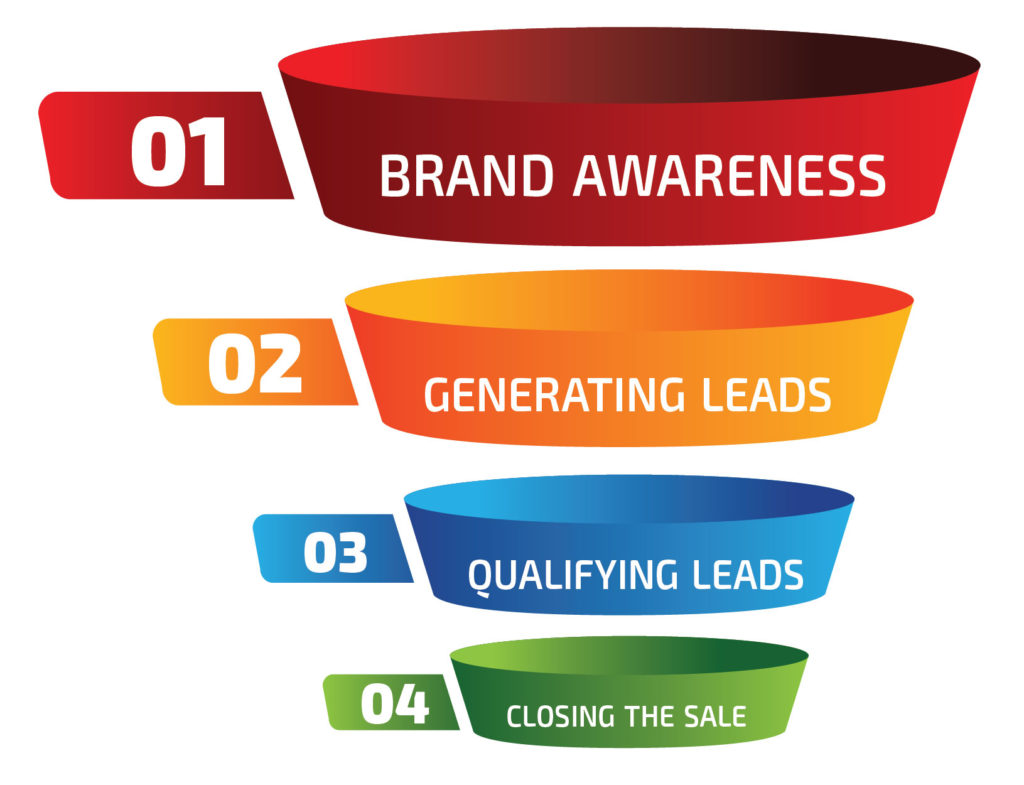
Why create an online sales funnel?
There are many important elements that work together to drive success for a business. But at the end of the day, above anything else, what most small business owners want is to gain more customers and increase sales. As marketers, it is our job to take prospects on an enjoyable journey through the buying process. From the first time your prospect hears about you until the moment of purchase, your prospect passes through different stages of your online sales funnel. It is important that we think like our customers so we can understand how to develop an appropriate process that leads prospects to ultimately purchase our products or services. We are all consumers so let’s put ourselves in the consumer’s mindset for just a moment. Let’s think about the steps we take that lead us to our buying decisions. Let’s use our experience to create an online sales funnel that can help you maximize your efforts and close the sale.
 Stages in our buying process
Stages in our buying process
Awareness | Interest | Decisions | Action
Before we get started in let’s start with the basics, what is a sales funnel?
A sales funnel is a series of steps designed to guide visitors towards a buying decision. An online sales funnel refers to the process specifically in the internet realm.
Step 1: Brand Awareness
At this stage consumers are learning about a product or a solution that can potentially fit their needs. Consumers are in the early stages of learning about a brand.
Effective ways to spread awareness:
Social Media: Creating a strong social media presence has proven to be an efficient way to build a company’s reputation and showcase a business. By regularly and creatively updating and maintaining social media posts, followers subconsciously start to become aware of the brand and how they can benefit from a company’s product or services.
Blogs: Blogging is a powerful platform to establish a company as an expert and thought leader in their field. A company can blog about issues and topics related to their industry, discuss the need for their product or service, and share useful and educational content to their target audience. Blogs create credibility while generating solid content for a company website and social media outlets.
Traditional and Digital Advertising: Advertising allows companies to display brand messaging through rich visuals, animated banners, audio or video in front of a targeted audience. Each advertising medium is unique and caters to specific goals that an advertiser needs to be achieved. A company looking to boost broad brand awareness may choose, for example, radio and TV advertising, while a company looking to boost sales of a particular product to a particular audience may choose Google AdWords or Facebook advertising to reach a unique and specific audience.
Step 2: Generating Leads
The next step in the buying process is consumer interest in a product or service. At this stage we are actively looking for solutions to our problems or ways to achieve our goals. A solid lead is generated if a consumer believes a solution might match their need.
Effective ways to generate leads:
Landing page: A website landing page is simply a highly focused web page that, when used for advertising, can deliver information and capture leads. Landing pages typically have an online form or email subscription form, phone number or another call-to-action. Landing pages not only allow a company to gather leads as people learn more about a solution and hopefully reach out to make a purchase or gather more information, but it can gather consumer data to store in a database for later marketing efforts.
Videos: Create educational videos that are snappy and creative. Use them in blogs and other website content, social media posts and digital advertising to educate and entertain your audience on topics that interest them. Videos that make an emotional and intellectual connection with consumers can build demand for a product or service. Moreover, a company’s YouTube channel is another avenue to stay in touch with customers and potential leads.
Email marketing: Turn website visitors, social media followers, and even walk-in customers into leads by asking them to subscribe to your email list. In return, make sure your email blasts and newsletters are worthwhile in some way to the consumer. Don’t expect people to open your newsletters or blasts without having a reason. Think about special offers and other creative messaging that would entice a consumer to read your content.
Step 3: Qualifying Leads
The next step in the buying process is a consumer making the decision to purchase a product or service that fits their specific needs.
Effective ways to qualify leads:
Two-way communication: Invite leads to chat with a sales representative via phone or instant messaging when they land on your website or see your ad. This allows potential customers to ask questions about your product or service in real time. Only interested, solid leads are likely to participate.
Email autoresponder sequence: After gathering leads for an email list, input them into an autoresponder sequence—a series of emails meant to drive readers toward action. The more subscribers open emails, click the link inside those emails, and respond, the more qualified a lead they usually are.
Step 4: Closing the Sale
The final stage in the buying process is the decision to make a purchase. At this stage a lead has been converted into a paying customer.
Your website can be critical at this stage. By having an online presence, customers are able at their leisure to browse through a website and choose the products or services that best fit their needs. It’s critical that there is always a call-to-action of some type to entice website visitors to take a specific action like filling out a form, making a phone call, or buying a product or service.
As marketers, It is important to think about how a company’s marketing and sales efforts can work together to put prospects on the right path. Don’t worry when every qualified lead doesn’t turn into a sale but consider the percentage that need to convert for a marketing effort to be successful. Consider your marketing costs vs the revenue generated by a new customer and look at your return-on-investment. Look at ways to optimize marketing strategies. Tweak as necessary to attain the results you need. There is no cookie cutter way to generate sales. Don’t be afraid to take intelligent risks.

